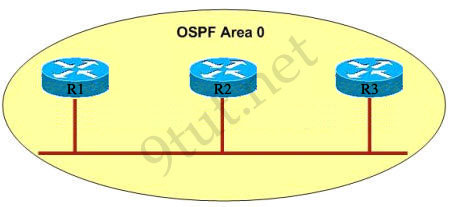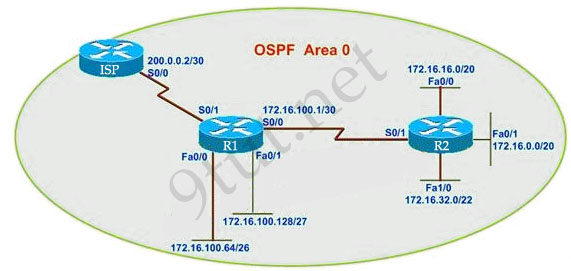CCNA – OSPF Questions
Here you will find answers to OSPF Questions
Note: If you are not sure about OSPF, please read my OSPF tutorial
Question 1
Which of the following statements below best describe the process identifier that is used to run OSPF on a router? (Choose two)
A – It is an optional parameter required only if multiple OSPF processes are running on the router
B – It is locally significant
C – It is needed to identify a unique instance of an OSPF database
D – All routers in the same OSPF area must have the same process ID if they are to exchange routing information
Answer: B C
Question 2:
Why R1 can’t establish an OSPF neighbor relationship with R3 according to the following graphic? (Choose two)

A – Configure EIGRP on these routers with a lower administrative distance
B – All routers should be configured for backbone Area 1
C – R1 and R3 have been configured in different areas
D – The hello and dead interval timers are not configured the same values on R1 and R3
Answer: C D
Explanation:
A is not correct because configure EIGRP on these routers (with a lower administrative distance) will force these routers to run EIGRP, not OSPF.
B is not correct because the backbone area of OSPF is always Area 0.
C and D are correct because these entries must match on neighboring routers:
– Hello and dead intervals
– Area ID (Area 0 in this case)
– Authentication password
– Stub area flag
Question 3:
Which items are correct about the routing protocol OSPF? (Choose three)
A – Support VLSM
B – Increase routing overhead on the network
C – Confine network instability to one area of the network
D – Allow extensive control of routing updates
Answer: A C D
Explanation:
Routing overhead is the amount of information needed to describe the changes in a dynamic network topology. All routers in an OSPF area have identical copies of the topology database and the topology database of one area is hidden from the rest of the areas to reduce routing overhead because fewer routing updates are sent and smaller routing trees are computed and maintained (allow extensive control of routing updates and confine network instability to one area of the network).
Question 4:
Which three features are of OSPF routing protocol? (Choose three)
A – Converge quickly
B – OSPF is a classful routing protocol
C – Identify the best route by use of cost
D – Before exchanging routing information, OSPF routers find out neighbors
Answer: A C D
Question 5:
OSPF routing uses the concept of areas. What are the characteristics of OSPF areas? (Chose three)
A – Each OSPF area requires a loopback interface to be configured
B – Areas may be assigned any number from 0 to 65535
C – Area 0 is called the backbone area
D – Hierarchical OSPF networks do not require multiple areas
E – Multiple OSPF areas must connect to area 0
F – Single area OSPF networks must be configured in area 1
Answer: B C E
Explanation:
I used to think the answers should be C D E and here is my explanation:
OSPF can use an active interface for its router ID, so a loopback interface is not a must -> A is incorrect.
OSPF Area is a 32-bit number so we can use up to 232 – 1 = 4294967296 – 1 (since Area 0 is the first area). Remember that only process ID is a 16-bit number and ranges from 1 to 65535 -> B is incorrect.
F is incorrect too because single area OSPF netwoks must be configured in Area 0, which is called the backbone area.
For answer D, it is a bit hard to guess what they want to say about “hierarchical” but we should understand “Hierarchical OSPF networks” as “OSPF networks”. D is correct bercause we can only have one area (area 0 – the backbone area) for our networks.
But TT commented on 01-11-2010:
Especially to note on choice B, D, and E:
Choice B: we all know that The areas can be any number from 0 to 4.2 billion and 1 to 65,535 for the Process ID. As choice B specifies ‘area’ (be aware, it’s not saying ‘process id), there is no reason to say that we cannot assign numbers from 0 to 65535 for area # (it is using ‘may be’, not ‘have to be’ or ‘ought to be’). Hence, we do not worry about assigning ‘0’.
Choice E: as Area 0 is the backbone, we all understand that any areas in a OSPF network have to be connected to it. And actually this is implicitly saying that multiple areas form a hierarchical OSPF network, as Area 0 being a root and others being its leaves.
Choice D: when it specifies ‘Hierarchical’, at least 2 areas should be required to form such topology (of course that includes Area 0)
Although Choice B is not an absolutely accurate statement since it not only can be assigned up to 65535, it is still a correct answer. And again, it specifies ‘area’, not ‘process id’, so ‘0’ can be included. Finally, it would be meaningless to call OSPF a hierarchical network if no more than one area is present.
—————————————————————————————————-
I reviewed the question and think it is a more suitable solution with choice B than choice D, surely it is a tricky question!
Question 6:
Part of the OSPF network is shown below:

Configuration exhibit:
R1 routing commands:
ip route 0.0.0.0 0.0.0.0 serial0/0
router ospf 1
network 172.16.100.0 0.0.0.3 area 0
network 172.16.100.64 0.0.0.63 area 0
network 172.16.100.128 0.0.0.31 area 0
default-information originate
You work as a network technician, study the exhibits carefully. Assume that all router interfaces are operational and correctly configured. In addition, assume that OSPF has been correctly configured on router R2. How will the default route configured on R1 affect the operation of R2?
A – Any packet destined for a network that is not directly connected to router R2 will be dropped immediately
B – Any packet destined for a network that is not directly connected to router R1 will be dropped
C – Any packet destined for a network that is not directly connected to router R2 will be dropped immediately because of the lack of a gateway on R1
D – The network directly connected to a router R2 will not be able to communicate with the 172.16.100.0, 172.16.100.28 and 172.16.100.64 subnetworks.
E – Any packet destined for a network that is not referenced in the routing table of router R2 will be directed to R1. R1 will then send that packet back to R2 and a routing loop will occur
Answer: E
Explanation:
First, notice that the more-specific routes will always be favored over less-specific routes regardless of the administrative distance set for a protocol. In this case, because we use OSPF for three networks (172.16.100.0 0.0.0.3, 172.16.100.64 0.0.0.63, 172.16.100.128 0.0.0.31) so the packets destined for these networks will not be affected by the default route.
The default route configured on R1 “ip route 0.0.0.0 0.0.0.0 serial0/0” will send any packet whose destination network is not referenced in the routing table of router R1 to R2, it doesn’t drop anything so answers A, B and C are not correct. D is not correct too because these routes are declared in R1 and the question says that “OSPF has been correctly configured on router R2”, so network directly connected to router R2 can communicate with those three subnetworks.
As said above, the default route configured on R1 will send any packet destined for a network that is not referenced in its routing table to R2; R2 in turn sends it to R1 because it is the only way and a routing loop will occur.


